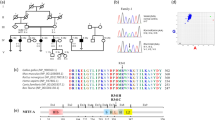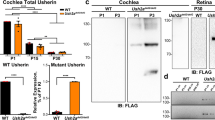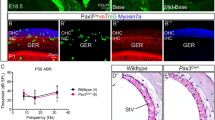Abstract
Waardenburg syndrome type 2 (WS2) is a dominantly inherited syndrome of hearing loss and pigmentary disturbances. We recently mapped a WS2 gene to chromosome 3p12.3–p14.1 and proposed as a candidate gene MITF, the human homologue of the mouse microphthalmia (mi) gene. This encodes a putative basic–helix–loop–helix–leucine zipper transcription factor expressed in adult skin and in embryonic retina, otic vesicle and hair follicles. Mice carrying mi mutations show reduced pigmentation of the eyes and coat, and with some alleles, microphthalmia, hearing loss, osteopetrosis and mast cell defects. Here we show that affected individuals in two WS2 families have mutations affecting splice sites in the MITF gene.
This is a preview of subscription content, access via your institution
Access options
Subscribe to this journal
Receive 12 print issues and online access
$209.00 per year
only $17.42 per issue
Buy this article
- Purchase on Springer Link
- Instant access to full article PDF
Prices may be subject to local taxes which are calculated during checkout
Similar content being viewed by others
References
Waardenburg, P.J. A new syndrome combining developmental anomalies of the eyelids, eyebrows and nose root with pigmentary defects of the iris and head hair and with congenital deafness. Am. J. hum. Genet. 3, 195–253 (1951).
Tassabehji, M. et al. Waardenburg syndrome patients have mutations in the human homologue of the Pax-3 paired box gene. Nature 355, 635–636 (1992).
Baldwin, C.T., Hoth, C.F., Amos, J.A., da-Silva, E.O. & Milunsky, A. An exonic mutation in the HuP2 paired domain gene causes Waardenburg's syndrome. Nature 355, 637–638 (1992).
Tassabehji, M. et al. PAX3 gene structure and mutations: close analogies between Waardenburg syndrome Type 1 and the Splotch mouse. Hum. molec. Genet. 3, 1069–1074 (1994).
Hughes, A., Newton, V.E., Liu, X.Z. & Read, A.P. A gene for Waardenburg syndrome type 2 maps close to the human homologue of the microphthalmia gene at chromosome 3p12–p14.1. Nature Genet. 7, 509–512 (1994).
Asher, J.H. & Friedman, T.B. Mouse and hamster mutants as models for Waardenburg syndrome in humans. J. med. Genet. 27, 618–626 (1990).
Lyon, M. & Searle, A.G. Genetic variants and strains of the laboratory mouse 2nd edn (Oxford University Press, Oxford, 1989).
Hodgkinson, C.A. et al. Mutations at the mouse microphthalmia locus are associated with defects in a gene encoding a novel basic helix-loop-helix zipper protein. Cell 74, 395–404 (1993).
Tachibana, M. et al. Cloning of MITF, the human homolog of the mouse microphthalmia gene and assignment to chromosome 3p14.1-p12.3. Hum. molec. Genet. 3, 553–557 (1994).
Anand, R., Riley, J.H., Butler, R., Smith, J.C. & Markham, A.F. A 3.5 genome equivalent multi-access YAC library: construction, characterisation, screening and storage. Nucl. Acids Res. 18, 1951–1956 (1990).
Riley, J. et al. A novel rapid method for the isolation of terminal sequences from yeast artificial chromosome (YAC) clones. Nucl. Acids Res. 18, 2887–2890 (1990).
Naylor, S.L., Buys, C.H.C.M. & Carritt, B. Report on the Fourth International Chromosome 3 Workshop. Cytogenet. Cell Genet. 65, 1–50 (1993).
Krawczak, M., Reiss, J. & Cooper, D.N. The mutational spectrum of single base-pair substitutions in mRNA splice junctions of human genes: causes and consequences. Hum. Genet. 90, 41–54 (1992).
Arias, S. & Mota, M. Apparent non-penetrance for dystopia in Waardenburg syndrome Type 1 with some hints on the diagnosis of dystopia canthorum. Journal de Génétique Humaine 26, 101–131 (1978).
Farrer, L.A. et al. Locus heterogeneity for Waardenburg syndrome is predictive of clinical subtypes. Am. J. hum. Genet. (in the press).
Author information
Authors and Affiliations
Rights and permissions
About this article
Cite this article
Tassabehji, M., Newton, V. & Read, A. Waardenburg syndrome type 2 caused by mutations in the human microphthalmia (MITF) gene. Nat Genet 8, 251–255 (1994). https://doi.org/10.1038/ng1194-251
Received:
Accepted:
Issue Date:
DOI: https://doi.org/10.1038/ng1194-251
This article is cited by
-
The C-terminal transactivation domain of MITF interacts promiscuously with co-activator CBP/p300
Scientific Reports (2023)
-
A unique hyperdynamic dimer interface permits small molecule perturbation of the melanoma oncoprotein MITF for melanoma therapy
Cell Research (2023)
-
Waardenburg syndrome type 4 coexisting with open-angle glaucoma: a case report
Journal of Medical Case Reports (2022)
-
Genetic insights, disease mechanisms, and biological therapeutics for Waardenburg syndrome
Gene Therapy (2022)
-
Four mutations in MITF, SOX10 and PAX3 genes were identified as genetic causes of waardenburg syndrome in four unrelated Iranian patients: case report
BMC Pediatrics (2021)



